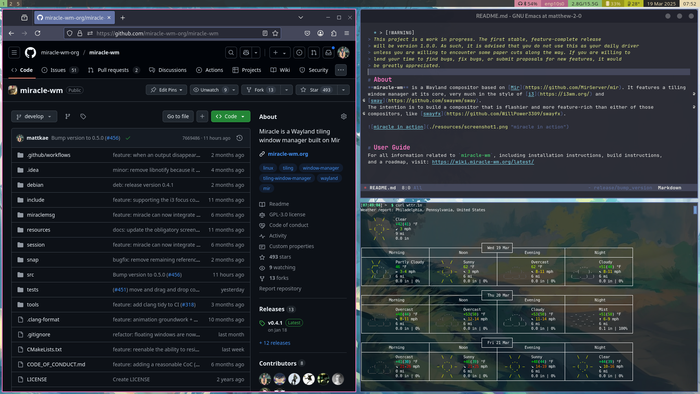Matthew Kosarek, a developer from Canonical, published the release of a composite manager miracle-wm 0.8, using the Wayland protocol and components for building composite managers Mir. Miracle-wm supports tiling window layouts, similar to those in the i3 and Sway projects. Waybar can be used as a panel. The project code is written in C++ and is distributed under the GPLv3 license. Ready-made assemblies are generated in the snap format, as well as in rpm and deb packages for Fedora and Ubuntu.
The goal of miracle-wm is to create a composite server that uses tiling window management, but is more functional and stylish than products like Swayfx. At the same time, the project allows you to use classic techniques for working with floating windows, for example, you can place individual windows on top of a mosaic grid or pin windows to a specific place on the desktop. Virtual desktops are supported, with the ability to set each desktop to have its own default window mode (tiled layout or floating windows).
It is expected that miracle-wm may be useful to users who prefer a tiled layout, but want visual effects and brighter graphics with smooth transitions and colors. The configuration is defined in the YAML format. To install miracle-wm, you can use the command “sudo snap install miracle-wm –classic”.

Main innovations:
- Added tools to simplify the work of people with disabilities, such as clicking when hovering and holding the cursor on a given element; simulation of a right-click by holding the left mouse button; enlarging the contents of the selected area on the screen; adding a delay for processing key presses; sequential application of keyboard shortcuts on one key without simultaneously holding several keys.
- Added support for connecting output filters that use shaders for the final rendering.
- Added a set of options for configuring touchpads, such as automatically disabling the touchpad when a mouse is present and when typing on the keyboard, controlling scroll speed and sensitivity, emulating mouse buttons, touch clicking and two-finger scrolling.